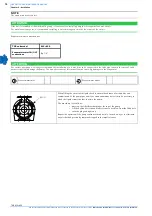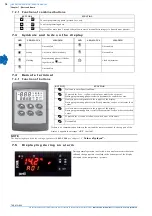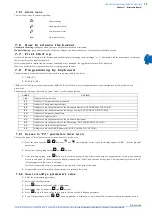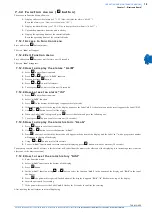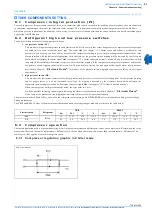
11
OPERATING AND MAINTENANCE MANUAL
Chapter 5 - Installation
TAE K15÷K20
The data in this manual are not binding and may be changed by the manufacturer without notice.
Reproduction of this manual, even partial, is strictly prohibited.
C
HAPTER
5
I
NSTALLATION
ATTENTION
Before carrying out the installation or operating on this machine, ensure that all the personnel has read and understood the Chapter 2
“Safety“
in this manual.
5 . 1
I n s p e c t i o n
Immediately after uncrating, inspect the unit.
5 . 2
P o s i t i o n i n g
1.
The unit may be installed both outdoors and indoors.
2.
If installed indoors, the room must be well ventilated and with a sufficient height which allows the air to be expelled by fans. In
some cases it may be necessary to install fans or extractors to limit the temperature of the room.
3.
The minimum and maximum working ambient temperature are specified on the unit data plate. In extreme temperature conditions,
the protection devices may trip.
4.
The machine must be positioned on any flat surface capable of supporting its weight.
5.
Leave at least one metre around the unit to permit access during service operations.
6.
Do not obstruct or disturb the condenser's flow of thermal exchanging air.
5 . 3
A n t i f r e e z e p r o t e c t i o n
Even if the minimum working ambient temperature is above 0°C it is possible for the machine - during stoppages in the cold seasons - to find
itself in an environment with a temperature below 0°C.
In these cases, if the machine is not emptied, antifreeze (ethylene glycol) must be added in the following percentages to prevent the formation of
ice:
Add the following anti-freeze (ethylene glycol) percentages in order to avoid freezing when operating at low water outlet temperature:
5 . 4
H y d r a u l i c c o n n e c t i o n s
NOTE
All hydraulic connections must be carried out by the customer.
1.
Connect the unit to the water piping respecting the water flow direction as indicated in the annexed overall dimension drawings.
2.
Provide two cocks (one at the inlet and one at the outlet) for excluding the unit when maintaining without emptying the user water
circuit.
3.
Fill the water receptacle by unscrewing the plug and filling the circuit with water (for example using a hose connected to the tap)
until the level in the receptacle is about half-way up the slot.
The receptacle used for filling the circuit acts as an open expansion tank. It is therefore necessary to pay attention to the volumes and dimensions
in play.
Ambient temperature up to
[°C] (°F)
Ethylene Glycol
[% in weight]
0 (32)
0
-5 (23)
15
-10 (14)
25
-15 (5)
30
Table 4
A
DDING
ETHYLENE
GLYCOL
BASED
ON
THE
AMBIENT
TEMPERATURE
Water outlet temperature up to
[°C] (°F)
Ethylene Glycol
[% in weight]
5 (41)
0
0 (32)
15
-5 (23)
20
-10 (14)
30
Table 5
A
DDITION
OF
E
THYLENE
GLYCOL
ACCORDING
TO
THE
WATER
OUTLET
TEMPERATURE














